Introduction
In the development of the whole computer technology In recent years, a course towards integration and the miniaturization that accompanies it has been well traced. And this is not so much about the usual desktop personal computers, but about a huge fleet of "user-level" devices - smartphones, laptops, players, tablets, etc. - which are reborn in new form factors, absorbing more and more new features. As for desktops, they are the last to be affected by this trend. Of course, in recent years, the vector of user interest has slightly deviated towards small computing devices, but it's hard to call this a global trend. The basic architecture of x86 systems, which assumes the presence of a separate processor, memory, video card, motherboard and disk subsystem, remains unchanged, and this is what limits the possibilities for miniaturization. It is possible to reduce each of the listed components, but there will not be a qualitative change in the dimensions of the resulting system in total.
However, during the last year, it seems, there has been some turning point in the environment of “personal computers”. With the introduction of modern semiconductor technological processes with more “thin” standards, x86 processor developers are able to gradually transfer the functions of some previously separate components and devices to the CPU. So, no one is surprised that the memory controller and, in some cases, the PCI Express bus controller, have long become a part of the central processor, and the motherboard chipset has degenerated into a single microcircuit - south bridge. But in 2011, a much more significant event happened - a graphics controller began to be integrated into processors for productive desktops. And we are not talking about some frail video cores that can only provide the operation of the operating system interface, but about quite complete solutions that can be opposed to entry-level discrete graphics accelerators in terms of performance and certainly surpass all those integrated video cores that were built into sets system logic previously.
The pioneer was Intel, which released processors for desktop computers at the very beginning of the year Sandy Bridge with an integrated graphics core of the Intel HD Graphics family. True, she considered that good integrated graphics would be of interest primarily to users. mobile computers, and for desktop CPUs, only a stripped-down version of the video core was offered. The incorrectness of this approach was later demonstrated by AMD, which launched Fusion processors with full-fledged graphics cores of the Radeon HD series on the desktop market. Such proposals immediately gained popularity not only as solutions for the office, but also as the basis for inexpensive home computers, which forced Intel to reconsider its attitude towards the prospects of CPUs with integrated graphics. The company has updated its Sandy Bridge line of desktop processors, adding models with a faster version of Intel HD Graphics to the number of available desktop offerings. As a result, now users who want to assemble a compact integrated system are faced with the question: which manufacturer's platform is more rational to prefer? After conducting comprehensive testing, we will try to give recommendations on choosing one or another processor with an integrated graphics accelerator.
Terminology question: CPU or APU?
If you are already familiar with those processors with integrated graphics that AMD and Intel offer for desktop users, then you know that these manufacturers are trying to distance their products from each other as much as possible, trying to instill the idea that their direct comparison is incorrect. It is AMD that brings the main “disturbance”, which refers its solutions to a new class of APUs, and not to ordinary CPUs. What is the difference?
The abbreviation APU stands for Accelerated Processing Unit (accelerated processing device). If we turn to detailed explanations, it turns out that from a hardware point of view, this is a hybrid device that combines traditional general-purpose computing cores with a graphics core on one semiconductor chip. In other words, the same CPU with integrated graphics. However, there is still a difference, and it lies at the program level. The graphics core included in the APU must have a universal architecture in the form of an array of stream processors capable of working not only on the synthesis of a three-dimensional image, but also on solving computational problems.
That is, the APU offers a more flexible scheme than simply combining graphics and computing resources within a single semiconductor chip. The idea lies in creating a symbiosis of these heterogeneous parts, when part of the calculations can be performed by means of the graphics core. However, as always in such cases, the support of the software.
AMD Processors Fusion with a video core, known under the code name Llano, fully comply with this definition, they are precisely APUs. They integrate graphics cores of the Radeon HD family, which, among other things, support ATI Stream technology and the OpenCL 1.1 software interface, through which calculations on the graphics core are really possible. In theory, a range of applications could benefit from running on an array of Radeon HD stream processors, including cryptographic algorithms, rendering 3D images or post-processing tasks for photos, sound and video. In practice, however, everything is much more complicated. Implementation difficulties and questionable real performance gains have so far held back widespread support for the concept. Therefore, in most cases, the APU can be considered nothing more than a simple CPU with an integrated graphics core.
Intel, on the other hand, sticks to more conservative terminology. It continues to refer to its Sandy Bridge processors, which contain integrated HD Graphics, by the traditional term CPU. Which, however, has some grounds, because the software interface OpenCL 1.1 is not supported by Intel graphics (compatibility with it will be provided in the next generation products). Ivy Bridge). So, no joint work of heterogeneous parts of the processor on the same computing tasks is foreseen by Intel yet.
With one important exception. The fact is that the graphics cores of Intel processors contain a specialized Quick Sync unit, focused on hardware acceleration of the video stream encoding algorithms. Of course, as in the case of OpenCL, it requires special software support, but it is really capable of improving performance when transcoding high-definition video by almost an order of magnitude. So in the end we can say that Sandy Bridge is to some extent also a hybrid processor.
Is it fair to compare AMD APUs and Intel CPUs? From a theoretical standpoint, an identical equal sign cannot be put between an APU and a CPU with a built-in video accelerator, but in real life we have two names for the same thing. AMD Llano processors can speed up parallel computing, and Intel Sandy Bridge processors can only use graphics power when transcoding video, but in reality, both possibilities are almost never used. So from a practical point of view, any of the processors discussed in this article is a regular CPU and a video card assembled inside one chip.
Processors - test participants
In fact, you should not think of processors with integrated graphics as some kind of special offer aimed at a certain group of users with atypical requests. Universal integration is a global trend, and such processors have become a standard offering in the lower and middle price range. Both AMD Fusion and Intel Sandy Bridge have been pushed out of the current offerings of CPUs without graphics, so even if you are not going to bet on the integrated video core, we can’t offer anything else but to focus on the same processors with graphics. Fortunately, no one is forcing you to use the built-in video core, and you can turn it off.
Thus, having taken up the comparison of the CPU with the integrated GPU, we have come to a more general task - comparative testing modern processors with a cost of 60 to 140 dollars. Let's see what suitable options AMD and Intel can offer us in this price range, and which specific processor models we managed to involve in the tests.
AMD Fusion: A8, A6 and A4
To use desktop processors with an integrated graphics core, AMD offers a dedicated Socket platform FM1, compatible exclusively with Llano processors - A8, A6 and A4. These processors feature two, three, or four general-purpose Husky cores with a microarchitecture similar to the Athlon II, and a Sumo graphics core that inherits the microarchitecture of the low-end Radeon HD 5,000 series.
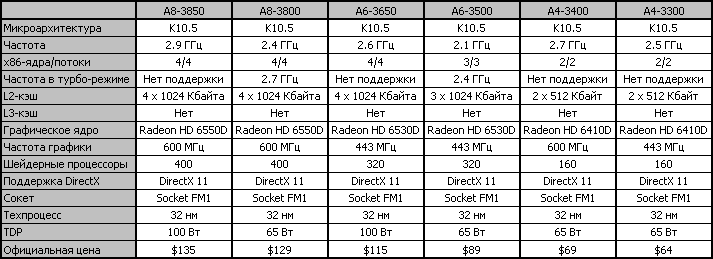
The line of processors of the Llano family seems to be quite self-sufficient, it includes processors that are heterogeneous in terms of computing and graphics performance. However, in model range there is one pattern - computing performance correlates with graphics performance, that is, processors with the largest number of cores and with maximum clock frequency are always supplied with the fastest video cores.
Intel Core i3 and Pentium
Intel can oppose AMD Fusion processors with its dual-core Core i3 and Pentium, which do not have their own collective name, but are also equipped with graphics cores and have a comparable cost. Of course, there are graphics cores in more expensive quad-core processors, but they play a clearly secondary role there, so at present core testing i5 and Core i7 didn't make it.
Intel did not create its own infrastructure for low-cost integrated platforms, so Core processors i3 and Pentium can be used in the same LGA1155 motherboards as the rest of Sandy Bridge. To use the built-in video core, you will need motherboards based on special H67, H61 or Z68 logic sets.

All Intel processors that can be considered as competitors for Llano are based on a dual-core design. At the same time, Intel does not put much emphasis on graphics performance - most CPUs have a weak version of HD Graphics 2000 graphics with six execution units built into them. An exception is made only for the Core i3-2125 - this processor is equipped with the most powerful HD Graphics 3000 graphics core in the company's arsenal with twelve actuators.
How We Tested
After we got acquainted with the set of processors presented in this test, it's time to pay attention to test platforms. Below is a list of components from which the composition of the test systems was formed.
Processors:
AMD A8-3850 (Llano, 4 cores, 2.9 GHz, 4 MB L2, Radeon HD 6550D);
AMD A8-3800 (Llano, 4 cores, 2.4/2.7 GHz, 4 MB L2, Radeon HD 6550D);
AMD A6-3650 (Llano, 4 cores, 2.6 GHz, 4 MB L2, Radeon HD 6530D);
AMD A6-3500 (Llano, 3 cores, 2.1/2.4 GHz, 3 MB L2, Radeon HD 6530D);
AMD A4-3400 (Llano, 2 cores, 2.7 GHz, 1 MB L2, Radeon HD 6410D);
AMD A4-3300 (Llano, 2 cores, 2.5 GHz, 1 MB L2, Radeon HD 6410D);
Intel Core i3-2130 (Sandy Bridge, 2 cores + HT, 3.4 GHz, 3 MB L3, HD Graphics 2000);
Intel Core i3-2125 (Sandy Bridge, 2 cores + HT, 3.3 GHz, 3 MB L3, HD Graphics 3000);
Intel Core i3-2120 (Sandy Bridge, 2 cores + HT, 3.3 GHz, 3 MB L3, HD Graphics 2000);
Intel Pentium G860 (Sandy Bridge, 2 cores, 3.0 GHz, 3 MB L3, HD Graphics);
Intel Pentium G840 (Sandy Bridge, 2 cores, 2.8 GHz, 3 MB L3, HD Graphics);
Intel Pentium G620 (Sandy Bridge, 2 cores, 2.6 GHz, 3 MB L3, HD Graphics).
Motherboards:
ASUS P8Z68-V Pro (LGA1155, Intel Z68 Express);
Gigabyte GA-A75-UD4H (Socket FM1, AMD A75).
Memory - 2 x 2 GB DDR3-1600 SDRAM 9-9-9-27-1T (Kingston KHX1600C8D3K2/4GX).
Hard drive: Kingston SNVP325-S2/128GB.
Power supply: Tagan TG880-U33II (880 W).
Operating system: Microsoft Windows 7SP1 Ultimate x64.
Drivers:
AMD Catalyst Display Driver 11.9;
AMD Chipset Driver 8.863;
Intel Chipset Driver 9.2.0.1030;
Intel Graphics Media Accelerator Driver 15.22.50.64.2509;
Intel management engine Driver 7.1.10.1065;
Intel Rapid Storage Technology 10.5.0.1027.
Since the main purpose of this test was to explore the capabilities of processors with integrated graphics, all tests were carried out without using an external graphic card. The built-in video cores were responsible for displaying the image on the screen, 3D functions and accelerating HD video playback.
At the same time, it should be noted that, due to the lack of DirectX 11 support in Intel graphics cores, testing in all graphic applications was carried out in DirectX 9/DirectX 10 modes.
Performance in common tasks
Overall Performance
To assess the performance of processors in common tasks, we traditionally use the Bapco SYSmark 2012 test, which simulates the user's work in common modern office programs and applications for creating and processing digital content. The idea of the test is very simple: it produces a single metric that characterizes the weighted average speed of the computer.
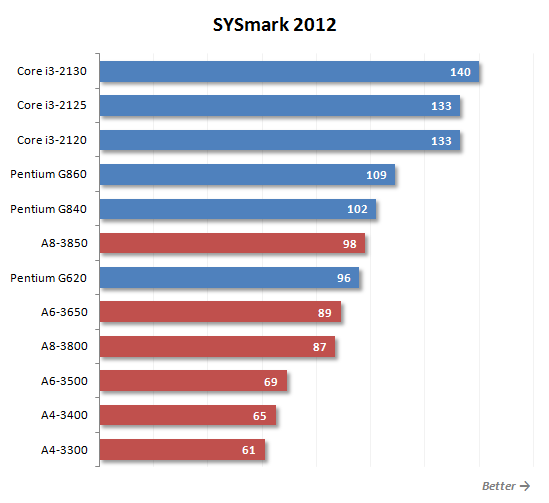
As you can see, in traditional applications, processors AMD series Fusion look just the same shameful. AMD's fastest quad-core Socket FM1 processor, the A8-3850, struggles to outperform the dual-core Pentium G620 at half the cost. All other representatives of the AMD A8, A6 and A4 series are hopelessly behind their Intel competitors. This, in general, is quite a natural result of the use of the old microarchitecture in the basis of Llano processors, which migrated there from Phenom II and Athlon II. Until AMD introduces processor cores with higher specific performance, even the company's quad-core APUs will have a very hard time competing with current and regularly updated Intel solutions.
A deeper understanding of the SYSmark 2012 results can provide insight into the performance scores obtained in various system usage scenarios. The Office Productivity scenario models typical office work: word preparation, spreadsheet processing, work with email and visiting Internet sites. The script uses the following set of applications: ABBYY FineReader Pro 10.0, Adobe Acrobat pro 9, Adobe Flash Player 10.1 Microsoft Excel 2010 Microsoft Internet Explorer 9, Microsoft Outlook 2010, Microsoft PowerPoint 2010, Microsoft Word 2010 and WinZip Pro 14.5.

The Media Creation scenario simulates the creation of a commercial using pre-captured digital images and video. For this purpose, popular Adobe packages are used: Photoshop CS5 Extended, Premiere Pro CS5 and After Effects CS5.

Web Development is a scenario that simulates the creation of a web site. Applications used: Adobe Photoshop cs5 Extended, Adobe Premiere Pro CS5, Adobe Dreamweaver CS5, Mozilla Firefox 3.6.8 and Microsoft Internet Explorer 9.

The Data/Financial Analysis scenario is dedicated to the statistical analysis and forecasting of market trends that are performed in Microsoft Excel 2010.
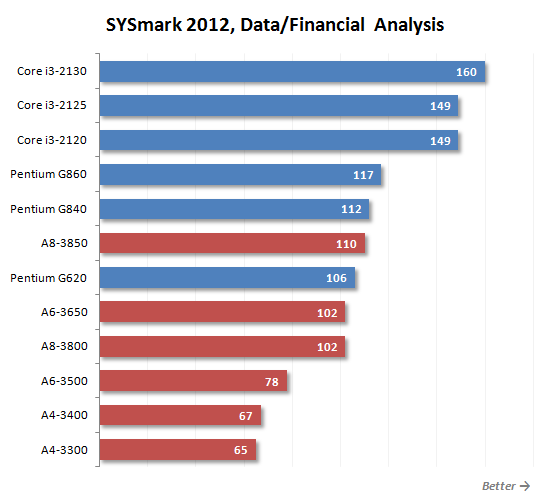
The 3D Modeling scenario is all about creating 3D objects and rendering static and dynamic scenes using Adobe Photoshop CS5 Extended, Autodesk 3ds Max 2011, Autodesk AutoCAD 2011 and Google SketchUp Pro 8.
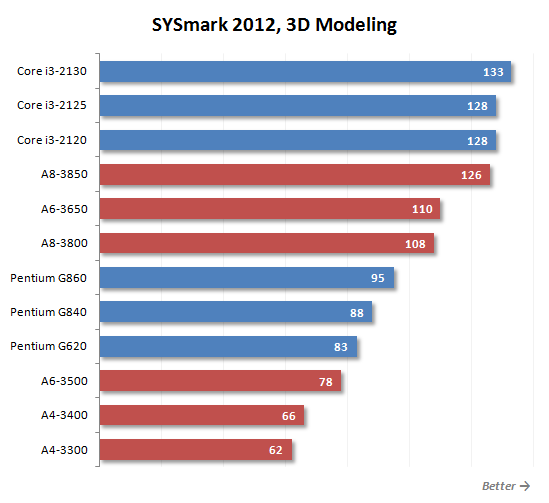
The last scenario, System Management, performs backups and installs software and updates. There are several different versions of Mozilla Firefox Installer and WinZip Pro 14.5.

The only type of application in which AMD Fusion processors can achieve acceptable performance is 3D modeling and rendering. In such tasks, the number of cores is a weighty argument, and the quad-core A8 and A6 can provide faster performance than, for example, the Intel Pentium. But to the level set by the Core i3 processors, which support Hyper-Threading technology, AMD offers do not reach even in the most favorable case for themselves.
Application performance
To measure the speed of processors when compressing information, we use the WinRAR archiver, with which we archive a folder with various files with a total volume of 1.4 GB with the maximum compression ratio.
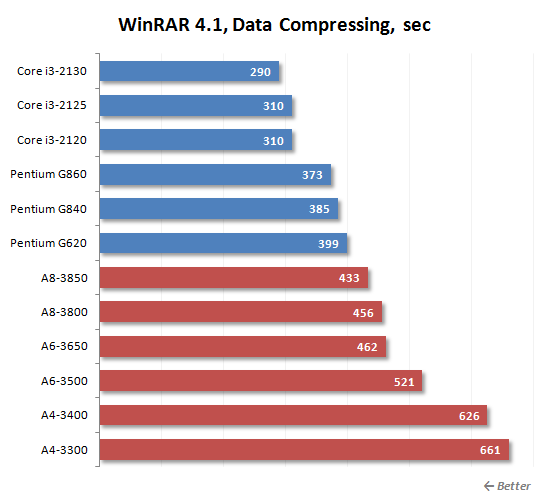
We measure performance in Adobe Photoshop using our own test, which is a creatively redesigned Retouch Artists Photoshop Speed Test, which includes a typical processing of four 10-megapixel images taken with a digital camera.

When testing the speed of transcoding audio, the Apple iTunes utility is used, with the help of which the contents of a CD are converted to AAC format. Note that a characteristic feature of this program is the ability to use only a couple of processor cores.
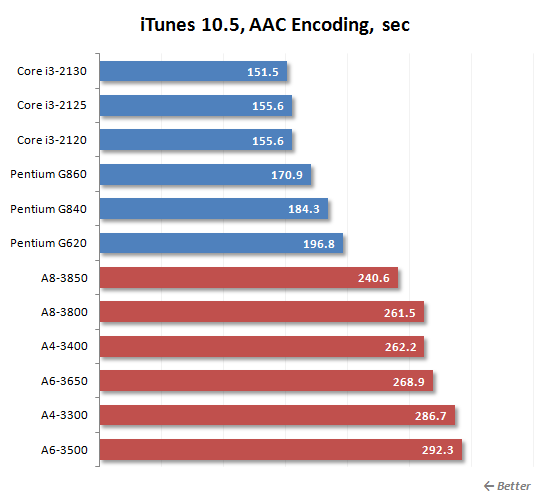
The x264 HD test is used to measure the speed of video transcoding to H.264 format. It should be noted that the results of this test are of great practical importance, since the x264 codec used in it underlies numerous popular transcoding utilities, such as HandBrake, MeGUI, VirtualDub, and so on.
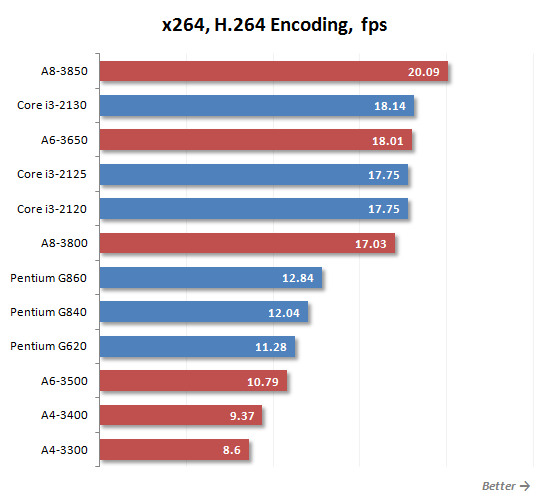
Final rendering speed testing in Maxon Cinema 4D is performed using a specialized Cinebench test.
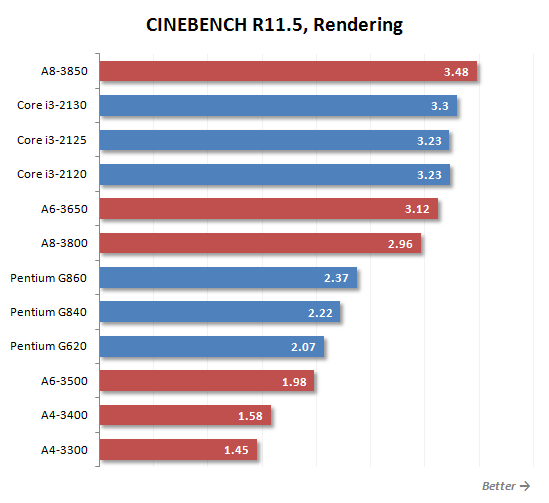
Also, we used the Fritz Chess Benchmark, which evaluates the speed of the popular chess algorithm used in the basis of programs of the Deep Fritz family.
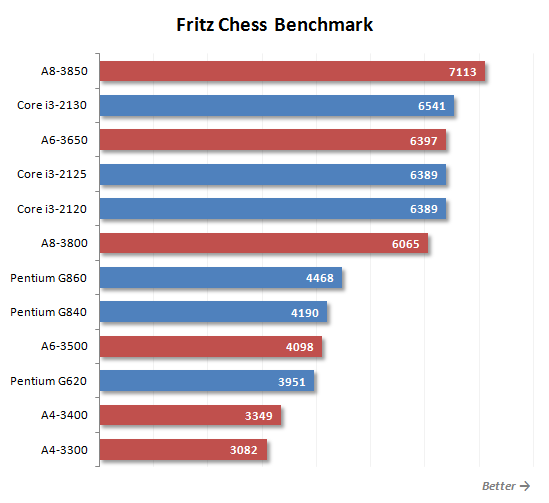
Looking at the above diagrams, one can once again repeat everything that has already been said in relation to the results of SYSmark 2011. AMD processors, which the company offers for use in integrated systems, can boast of any acceptable performance only in those computing tasks where the load is good. is parallelized. For example, during 3D rendering, video transcoding, or when iterating and evaluating chess positions. And then, a competitive level of performance in this case is observed only in the older quad-core AMD A8-3850 with a clock frequency that is increased to the detriment of power consumption and heat dissipation. Still, AMD processors with a 65-watt thermal package give in to any of the Core i3 even in the most favorable case for them. Accordingly, representatives of the Intel Pentium family look quite worthy against the background of Fusion: these dual-core processors perform approximately the same as the triple-core A6-3500 under a well-parallelized load, and outperform the older A8 in programs like WinRAR, iTunes or Photoshop.
In addition to the conducted tests, in order to check the effect with which the power of graphics cores can be involved in solving everyday computing tasks, we conducted a study on the speed of video transcoding in Cyberlink MediaEspresso 6.5. This utility has support for computing on graphics cores - it supports both Intel Quick Sync and ATI Stream. Our test was to measure the time required to downscale a 1.5GB 1080p H.264 video (which was a 20-minute episode of a popular TV series) downsampled for viewing on an iPhone 4.

The results are divided into two groups. The first includes Intel Core i3 processors, which have support for Quick Sync technology. Numbers speak louder than words: Quick Sync transcodes HD video content several times faster than any other tool. The second large group includes all other processors, among which CPUs with a large number of cores take the first places. The Stream technology promoted by AMD, as we see, does not show itself in any way, and the Fusion series APUs with two cores show no better result than Pentium processors, which transcode video exclusively by the computing cores.
Graphics core performance
A group of 3D gaming tests opens with the results of the 3DMark Vantage benchmark, which was used with the Performance profile.
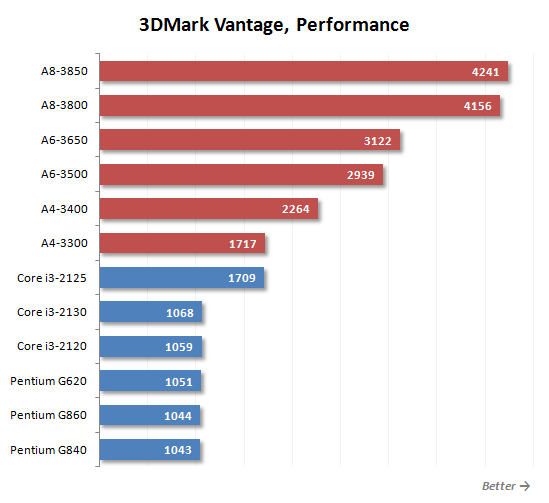
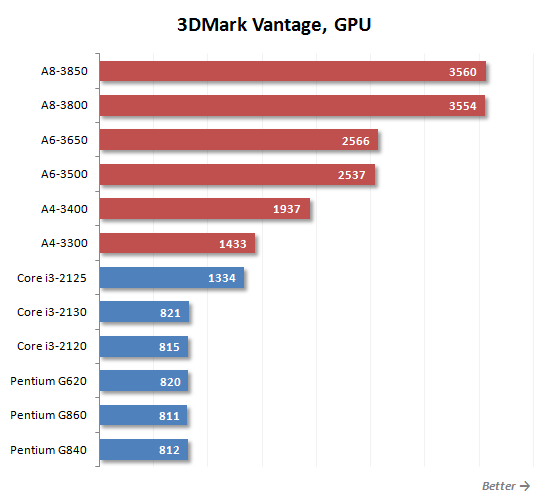

A change in the nature of the load immediately leads to a change in leaders. The graphics core of any AMD Fusion processors in practice outperforms any Intel HD Graphics options. Even the Core i3-2125, equipped with an HD Graphics 3000 video core with twelve execution units, is only able to achieve the performance level demonstrated by the AMD A4-3300 with the weakest Radeon HD 6410D integrated graphics accelerator among all those presented in the Fusion test. All other Intel processors in terms of 3D performance lose to AMD offers by two to four times.
Some compensation for the dip in graphics performance may come from the CPU test results, but it should be understood that CPU and GPU speed are not interchangeable parameters. It is necessary to strive for a balance of these characteristics, and how the situation is with the compared processors, we will see further by analyzing their gaming performance, which depends on the power of both the GPU and the computing component of hybrid processors.
To study the speed of work in real games, we selected Far Cry 2, Dirt 3, Crysis 2, World of Planes and Civilization V beta. Tested at 1280x800 with quality settings set to Medium.

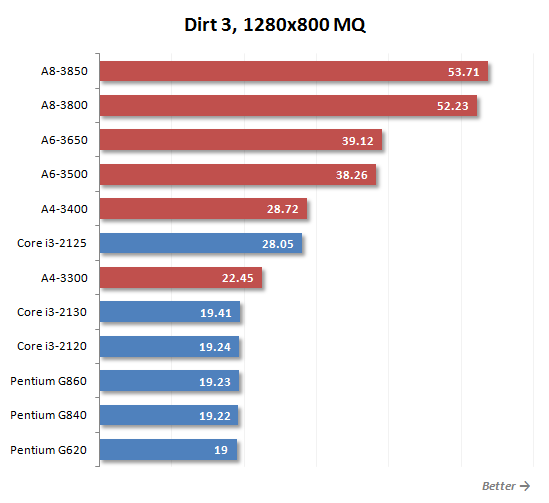
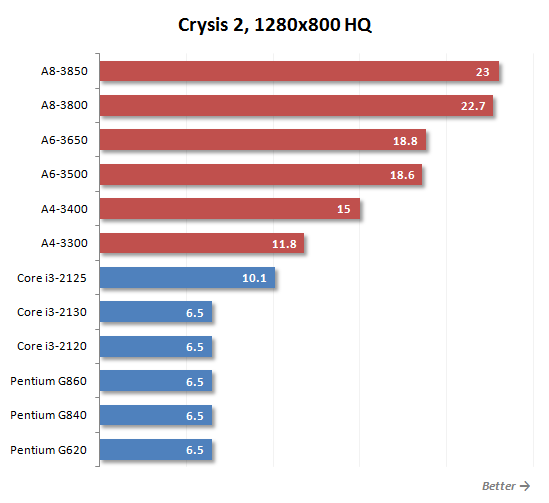


In gaming tests, the picture is very positive for AMD's proposals. Despite the fact that they differ in rather mediocre computing performance, powerful graphics allow them to show good (for integrated solutions) results. Almost always, representatives of the Fusion series allow you to get a higher number of frames per second than the Intel platform with processors of the Core i3 and Pentium families gives out.
Even the fact that Intel began to integrate a productive version of the HD Graphics 3000 graphics core into them did not save the position of the Core i3 processors. The Core i3-2125 equipped with it turned out to be faster than its fellow Core i3-2120 with HD Graphics 2000 by about 50%, but the graphics embedded in Llano, even faster. As a result, even the Core i3-2125 can compete only with the cheap A4-3300, while the rest of the Sandy Bridge microarchitecture carriers look even worse. And if we add to the results shown in the diagrams the lack of support for DirectX 11 in the video cores of Intel processors, then the situation for the current solutions of this manufacturer seems even more hopeless. Only the next generation of the Ivy Bridge microarchitecture can fix it, where the graphics core will receive both much higher performance and modern functionality.
Even if we ignore specific numbers and look at the situation qualitatively, AMD's offerings look like a much more attractive option for an entry-level gaming system. The older Fusion processors of the A8 series, with certain compromises in terms of screen resolution and image quality settings, allow you to play almost any modern game without resorting to the services of an external video card. We cannot recommend any Intel processors for cheap gaming systems - various options HD Graphics is not yet mature enough to be used in this environment.
Energy consumption
Systems based on processors with integrated graphics cores are gaining more and more popularity, not only due to the opening opportunities for system miniaturization. In many cases, consumers opt for them, guided by the opening opportunities to reduce the cost of computers. Such processors allow not only to save on a video card, they also allow you to assemble a more economical system in operation, since its total power consumption will be obviously lower than the consumption of a platform with discrete graphics. An accompanying bonus is quieter operating modes, since the reduction in consumption results in a reduction in heat generation and the possibility of using more simple systems cooling.
That is why developers of processors with integrated graphics cores are trying to minimize the power consumption of their products. Most of the CPUs and APUs reviewed in this article have a calculated typical heat dissipation in the range of 65 W - and this is an unspoken standard. However, as we know, AMD and Intel approach the TDP parameter somewhat differently, and therefore it will be interesting to evaluate the practical consumption of systems with different processors.
The following graphs show two values of energy consumption each. The first is total system consumption (without a monitor), which is the sum of the power consumption of all components involved in the system. The second is the consumption of only one processor on a 12-volt power line dedicated for this purpose. In both cases, the efficiency of the power supply is not taken into account, since our measuring equipment is installed after the power supply and captures the voltages and currents entering the system through 12-, 5-, and 3.3-volt lines. During the measurements, the load on the processors was created by the 64-bit version of the LinX 0.6.4 utility. The FurMark 1.9.1 utility was used to load the graphics cores. In addition, in order to properly assess idle power consumption, we have enabled all available energy-saving technologies, as well as Turbo Core technology (where it is supported).

At rest, all systems showed the total power consumption, which is approximately at the same level. At the same time, as we can see, Intel processors practically do not load the processor power line in idle time, while competing AMD solutions, on the contrary, consume up to 8 W on the 12-volt line dedicated to the CPU. But this does not at all indicate that the representatives of the Fusion family do not know how to fall into deep energy-saving states. The differences are due to the different implementation of the power supply scheme: in Socket FM1 systems, both the computing and graphics cores of the processor and the northbridge built into the processor are powered by the processor line, and in Intel systems, the northbridge of the processor takes power from the motherboard.
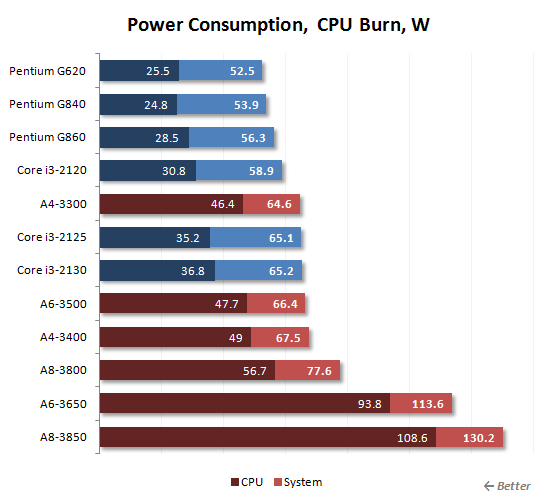
Peak Computing Load reveals that AMD's Phenom II and Athlon II energy efficiency issues persist with the introduction of 32nm technological process. Llano use the same microarchitecture and just as badly lose to Sandy Bridge in terms of performance per watt expended. Older Socket FM1 systems consume about twice as much as systems with LGA1155 Core i3 processors, despite the fact that the computing performance of the latter is clearly higher. The gap in power consumption between the Pentium and the younger A4 and A6 is not so huge, but nevertheless, the situation does not change qualitatively.
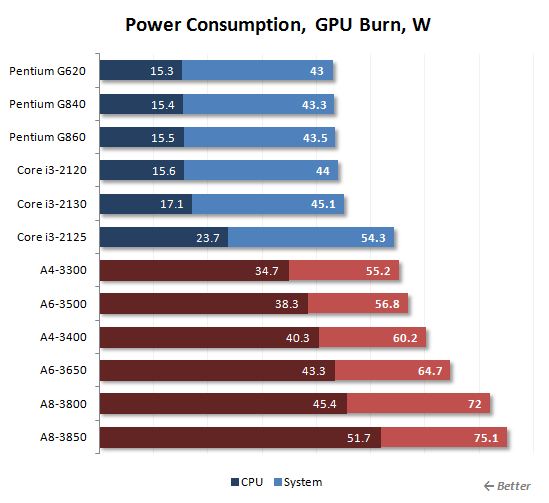
Under graphics load, the picture is almost the same - Intel processors are much more economical. But in this case, a good excuse for AMD Fusion can be their significantly higher 3D performance. Note that in gaming tests, the Core i3-2125 and A4-3300 “squeezed out” the same number of frames per second, and in terms of consumption when the graphics core is loaded, they also did not go far from each other.
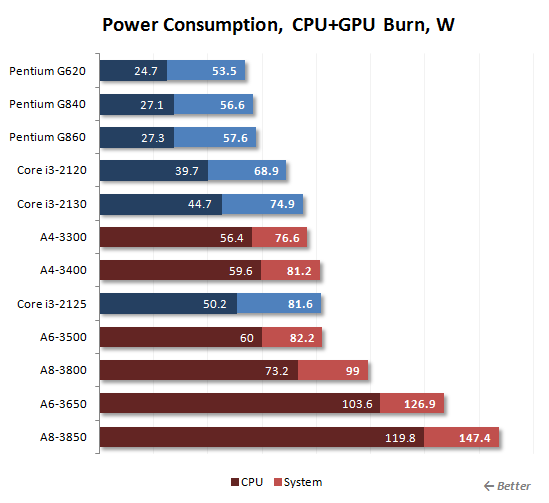
Simultaneous load on all units of hybrid processors allows you to get a result that can be figuratively represented as the sum of the two previous graphs. The A8-3850 and A6-3650 processors, which have a 100-watt thermal package, seriously break away from the rest of the rest of the mass of 65-watt offerings from AMD and Intel. However, even without them, Fusion processors are less economical than Intel Solutions the same price range.

When using processors as the basis of a media center playing high-definition video, an atypical situation arises. The computing cores here are mostly idle, and the decoding of the video stream is assigned to specialized blocks built into the graphics cores. Therefore, platforms based on AMD processors manage to achieve good power efficiency, in general, their consumption does not greatly exceed the consumption of systems with Pentium processors or Core i3. What's more, the lowest frequency AMD Fusion, the A6-3500 offers the best economy overall in this usage scenario.
At first glance, summing up the test results is easy. AMD and Intel processors with integrated graphics cores have shown completely different advantages, which allows us to recommend either one or another option, depending on the planned model of using the computer.
So, the strength of the AMD Fusion family of processors turned out to be the graphics core built into them with a relatively high performance and compatibility with software interfaces DirectX 11 and OpenCL 1.1. Thus, these processors can be recommended for those systems where the quality and speed of 3D graphics is not of the last importance. At the same time, processors included in the Fusion series use general-purpose cores based on the old and slow K10 microarchitecture, which results in their low performance in computing tasks. Therefore, if you are interested in options that provide better performance in normal non-gaming applications, you should look towards Intel's Core i3 and Pentium, even though such CPUs are equipped with fewer cores than AMD's competing offerings.
Of course, in general, AMD's approach to the design of processors with a built-in video accelerator seems to be more rational. The APU models offered by the company are well balanced in the sense that the speed of the computing part is quite adequate to the speed of the graphics and vice versa. As a result, the older processors of the A8 line can be considered as a possible basis for entry-level gaming systems. Even in modern games, such processors and the Radeon HD 6550D video accelerators integrated into them can provide acceptable playability. With the younger A6 and A4 series with weaker versions of the graphics core, the situation is more complicated. For universal gaming systems of a junior level, their performance is no longer enough, so you can bet on such solutions only when it comes to creating multimedia computers that will run exclusively graphically simple casual games or online role-playing games of past generations.
However, no matter what is said about balance, the A4 and A6 series are poorly suited for resource-intensive computing applications. Representatives within the same budget Intel line Pentiums can offer significantly faster computing performance. To tell the truth, against the backdrop of Sandy Bridge, only the A8-3850 can be called a processor with an acceptable speed in commonly used programs. And even then, its good results are far from being manifested everywhere and, moreover, are provided with increased heat dissipation, which not every computer owner without a discrete video card will like.
In other words, it's a pity that Intel still can't offer a decent performance graphics core. Even the Core i3-2125, equipped with the fastest Intel HD Graphics 3000 in the company's arsenal, works at the AMD A4-3300 level in games, since the speed in this case rests on the performance of the built-in video accelerator. All other Intel processors are completely equipped with a one and a half times slower video core, and in 3D games they perform very faded, often showing a completely unacceptable number of frames per second. Therefore, we would not recommend thinking about Intel processors as a possible basis for a system capable of working with 3D graphics. The Core i3 and Pentium video core does an excellent job of displaying the operating system interface and playing high-resolution video, but it is not capable of more. So, the most suitable application for Core i3 and Pentium processors seems to be in systems where the processing power of general-purpose cores is important with good energy efficiency - no AMD offerings with Sandy Bridge can compete in these parameters.
Well, in conclusion, it should be recalled that the Intel LGA1155 platform is much more promising than AMD socket FM1. When purchasing an AMD Fusion series processor, you must be mentally prepared for the fact that it will be possible to improve a computer based on it within very limited limits. AMD plans to release only a few more models of Socket FM1 representatives of the A8 and A6 series with a slightly increased clock speed, and their successors coming out next year, known under the code name Trinity, will not have compatibility with this platform. Intel's LGA1155 platform is much more promising. Not only can the much more computationally efficient Core i5 and Core i7 be installed in it today, but the Ivy Bridge processors planned for next year should work in motherboards purchased today.
19.04.2014 0 20437

There were times when a PC could not run any decent game if it did not have discrete graphics card. Today, most off-the-shelf computers and almost all laptops rely on graphics solutions integrated into the CPUs. Yet the discrete graphics market continues to thrive. If you don't play heavy AAA games, is the graphics card a worthwhile upgrade? To find out the answer, let's compare the performance of integrated and discrete GPUs.
AMD and Intel significantly improved the quality integrated graphics. AMD's Kaveri APUs use the same powerful GCN graphics core found in their top discrete Radeon series graphics cards.
Intel has also updated the features and capabilities of its graphics systems HD-series, which are built into the fourth generation Core processors (codenamed Haswell). They currently provide broader support for Microsoft DirectX 11.1, can support multiple displays (including 4K), and are compatible with most games.
To determine the advantages of a discrete graphics card, two computers were assembled. One runs on an A8-7800 Kaveri with an integrated Radeon R7 series GPU, and the other runs on an Intel Core i7-4670 Haswell processor with an integrated Intel HD 4600. Tests were then run with and without a discrete graphics card onboard each system.
The argument for discrete graphics
Behind discrete graphics says its performance. All but entry-level graphics cards have a much more powerful GPU than those integrated into processors. Moreover, a separate graphics card will provide a GPU dedicated high-speed memory pool. The integrated GPU should be content with sharing system memory and data buses. Usually with discrete card you can set the graphics settings in games higher than with integrated solutions.
There are other benefits to using discrete graphics cards as well. On current generation Nvidia graphics cards, users can use proprietary technologies Shadowplay and PhysX. ShadowPlay optimizes the use of video encoding engines built into NVIDIA GPUs to record and stream games in real time, with little impact on frame rates. This key feature portable gaming device Nvidia Shield.
PhysX is a proprietary physics simulation technology that makes objects in games behave more realistically. PhysX isn't supported by all games, but it can have a huge visual impact on those that do.
Games aren't the only applications that benefit from the performance of a discrete GPU. GPUs from AMD and Nvidia are made up of thousands of processors that can perform multiple operations at the same time. Any application can benefit from this parallel processing, be it image editing programs like Photoshop, data encryption, or distributed computing projects like Folding@Home or SETI@Home.
Discrete graphics cards can speed up the mining of the cryptographic currency Bitcoins, Litecoins and others. Miners bought up the latest graphics cards from AMD, as the Radeon architecture proved to be more efficient here than Intel processors and Nvidia graphics cards. Where is the processor Intel Haswell The Core i7-4770K is capable of processing about 93k hashes per second, the AMD Radeon R9 290X does about 880k hashes per second.
Argument against discrete graphics
Discrete video cards also have drawbacks, and the main one is the price. Buying a video card will cost from a couple of thousand rubles to 30 thousand or more. AMD recently announced the world's most powerful graphics card. The Radeon R9 295X2 has two Tahiti XT GPUs in one card and costs $1,500.
AMD and Intel almost completely abandoned processors without integrated graphics (only AMD's FX series and chips Ivy Bridge-E Intel does not have it), and motherboards that support these processors have a built-in video output.
A discrete graphics card also adds complexity to the system. The motherboard must have a free PCIe x16 slot for installing a video card. Usually it is available in the system unit, although some ready-made small computers may not have it, or the card may not fit inside the case. Or the power supply will not be able to support the requirements of the card. All this is because PC manufacturers did not anticipate, or simply did not take care of, that the end user could upgrade.
Installing a discrete graphics card with Intel processors, it can be difficult to use technologies such as the Quick Sync video encoding engine. Quick Sync linked to the integrated graphics Intel core, and installing a discrete card may disable it. Fortunately, it can be reactivated.
But you have to pay for everything. An external video card will increase power consumption, generate heat that requires a fan to remove (some cards even have three fans), and this will increase the noise level of the system as a whole. There are also passive cooling systems, but they are only suitable for entry-level cards and are more expensive.
Let's move on to numbers
Two computers were assembled: on an AMD A8-7600 APU with a Radeon R7 iGPU on an Asus A88X-Pro motherboard, and on an Intel Core i5-4670 with an Intel HD 4600 on Gigabyte board Z87X-UD5 TH. Both systems were equipped with 16 GB of memory, solid state drive Samsung 840 Pro SSD and 1000W Silverstone PSU, operating system- 64-bit Windows 8.1 Pro.
A series of tests were conducted, including games and content creation applications, using only integrated GPUs. After that, a Radeon R9 280X video card from XFX was installed in the systems and the tests were repeated.
As you can see from the graphs, having a discrete graphics card improves performance in almost every way, and not just in games. PCMark 8, for example, launched Home and Work versions with OpenGL support. This interface uses all available computing resources of the computer, both the central processor and the graphics. The addition of a discrete graphics card increased system performance in this benchmark by 3-19% (Figure 1).

In the multi-threaded Cinebench test, the video card had little effect, but with OpenGL on a system with Intel processor the video card gave a performance increase of 79%, in the AMD system - 42% (Figure 2).

Many people think that people who play simple games - Farmville, Angry Birds, etc. - will not get any benefit from discrete graphics. But adding a graphics card gave a significant performance boost in the HTML5-oriented Fishbowl benchmark. This test is limited to 60 frames per second (the refresh rate of most monitors), and this value was achieved in three of the four tests with a discrete card (Figure 3). "Casual" games are becoming more and more difficult, their requirements for video cards are growing accordingly.

Speaking of complex games, the graphics cards performed well in BioShock Infinite at 1920 x 1080 pixels (Figure 4) and the 3DMark Fire Strike synthetic gaming test.
There is one area where the addition of a discrete video adapter hasn't had a significant impact: video playback. There was very little CPU impact when running both YouTube (HTML5) videos and H.264 encoded files in an MKV container.
Conclusion: Almost every desktop user can benefit from a graphics card. They will come in handy not only for gamers, although, of course, they get the main benefit.
P.S. If you have any problems with the equipment, please contact our computer service, or order a visit
built-in GPU both for gamers and for undemanding users plays an important role.
The quality of games, movies, watching videos on the Internet and images depends on it.
Principle of operation
![]()
The GPU is integrated into motherboard computer - this is what the built-in graphic looks like.
As a rule, they use it to remove the need to install a graphics adapter -.
This technology helps to reduce the cost of the finished product. In addition, due to the compactness and undemanding power consumption of such processors, they are often installed in laptops and low-power desktop computers.
Thus, integrated graphics processors have filled this niche so much that 90% of laptops on US store shelves have just such a processor.
Instead of a conventional video card in integrated graphics, the computer's RAM itself often serves as an auxiliary tool.
True, this solution somewhat limits the performance of the device. Yet the computer itself and the GPU use the same bus for memory.
So such a “neighborhood” affects the performance of tasks, especially when working with complex graphics and during gameplay.
Kinds
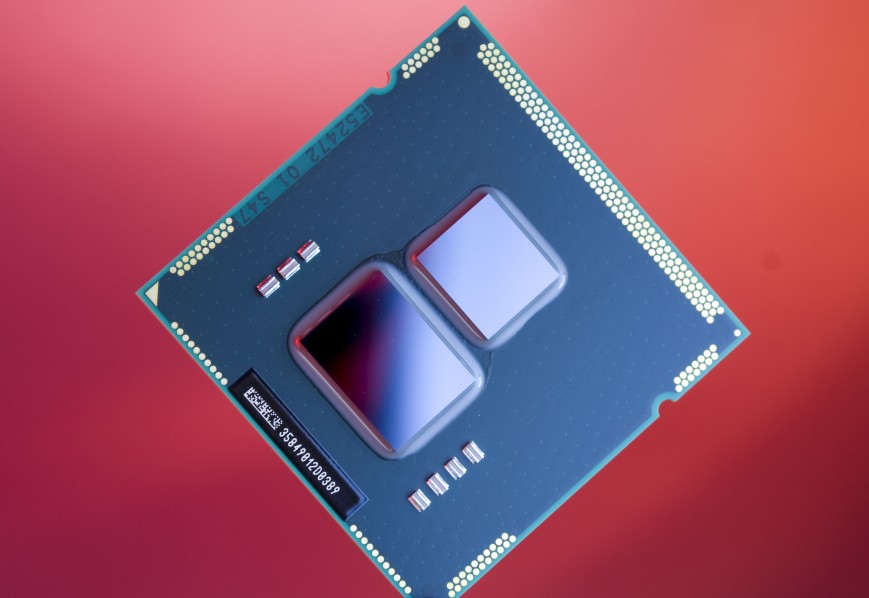
Integrated graphics have three groups:
- Shared memory graphics - a device based on shared control with the main processor RAM. This greatly reduces the cost, improves the energy saving system, but degrades performance. Accordingly, for those who work with complex programs, integrated GPUs of this kind are more likely to not work.
- Discrete graphics - the video chip and one or two video memory modules are soldered to system board. Thanks to this technology, image quality is significantly improved, and it also becomes possible to work with 3D graphics with the best results. True, you will have to pay a lot for this, and if you are looking for a high-performance processor in all respects, then the cost can be incredibly high. In addition, the electricity bill will rise slightly - the power consumption of discrete GPUs is higher than usual.
- Hybrid discrete graphics - a combination of the two previous types, which ensured the creation of the PCI Express bus. Thus, access to the memory is carried out both through the soldered video memory and through the operational one. With this solution, the manufacturers wanted to create a compromise solution, but it still does not eliminate the shortcomings.
Manufacturers
As a rule, large companies are engaged in the manufacture and development of embedded graphics processors -, and, but many small enterprises are also connected to this area.
It's easy to do. Look for Primary Display or Init Display First. If you do not see something like this, look for Onboard, PCI, AGP or PCI-E (it all depends on the installed buses on the motherboard).
By selecting PCI-E, for example, you enable the PCI-Express video card, and disable the built-in integrated one.
Thus, to enable the integrated video card, you need to find the appropriate parameters in the BIOS. Often the activation process is automatic.
computer processor(central processing unit, CPU) - the most important part system block. From the choice of processor envy the performance and power of your computer. We will now consider how to choose a processor.
Main characteristics of the processor
Frequency (clock frequency)
The frequency indicates how many operations (cycles) the processor can perform in one second. A very important parameter. The higher the frequency, the better.
Number of Cores
Almost all modern processors are multi-core, that is, they have two or more cores. Even office computers and low-powered netbooks are based on multi-core processor. Theoretically, the more cores a processor has, the better, but this is not entirely true. A computer with more cores will only run faster if it has multiple programs running at once, or if the program is optimized for multiple cores. That is, in some programs you will feel tangible performance, while in others you will not notice anything.
Do not chase processors with a large number of cores. In fact, by paying for an expensive eight-core computer, you will use only a small part of its potential. The best option is a quad-core or dual-core computer.
Cache
To increase the speed of data exchange with RAM, blocks of high-speed memory - Cache are built into the processor. There are three levels of cache: first, second, third. The larger the cache, the better. Just like frequency, cache size is an important parameter.
Integrated graphics core.
Processors with a built-in graphics core eliminate the need to buy a video card for a computer. But that's just for office computers. Powerful gaming and multimedia computers need to buy a video card separately. The built-in graphics core of modern processors allows you to play HD video and play not very demanding games. If you buy such a processor, make sure that your motherboard's chipset allows you to use the integrated graphics core.
Socket (socket)
socket- This is the socket on the motherboard where the processor is installed. When choosing a processor, make sure that the socket of the processor and the motherboard match (you can insert such a processor into the motherboard).
Technological process (technical process)
This is the scale of production technology. The lower the process technology indicator, the more elements can be built into it and the more modern it is.
Delivery type
You can often notice that when selling a processor, “BOX” is indicated. This entry means that the processor comes with a cooler (cooling device). I would recommend choosing a cooler separately, since quite often there were situations when the cooler included in the kit was very noisy.
Based on these characteristics, you can choose a processor for your computer. To simplify the search for a processor, you can use. Here are the best options for processors in different price categories.
I hope I have explained everything clearly, and you have learned how to choose a processor. If you have any questions - write them in the comments.




